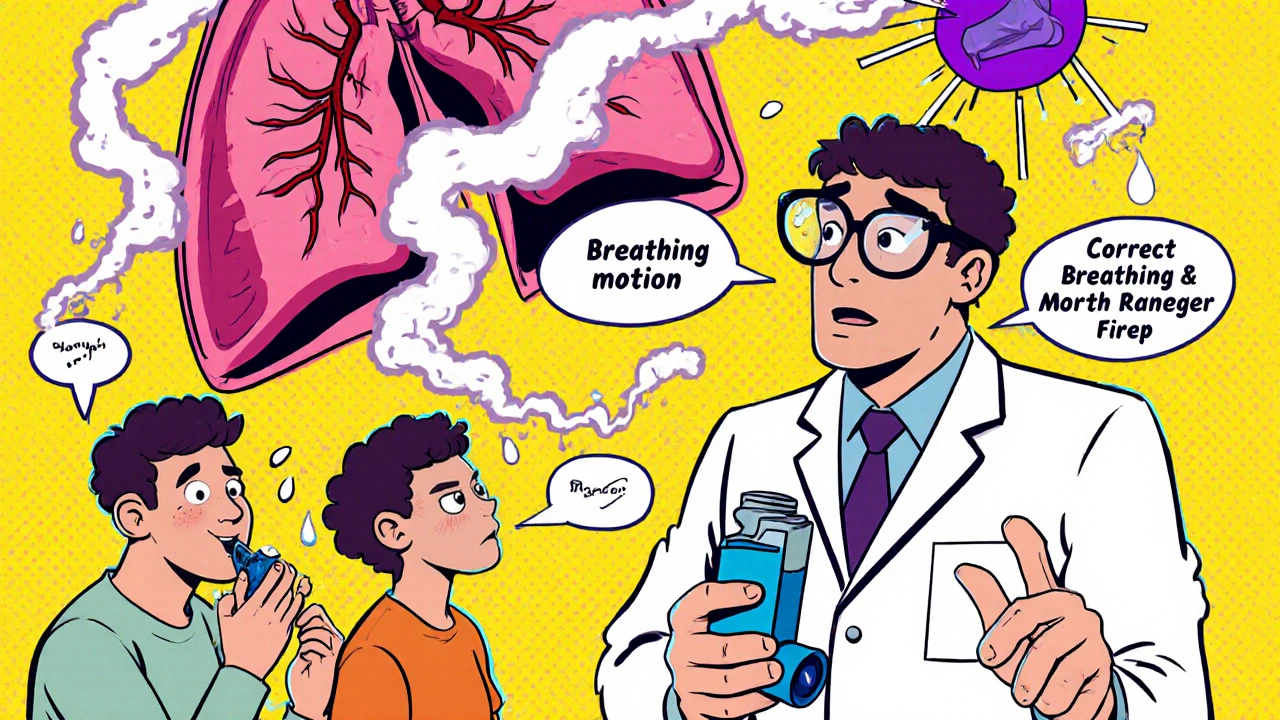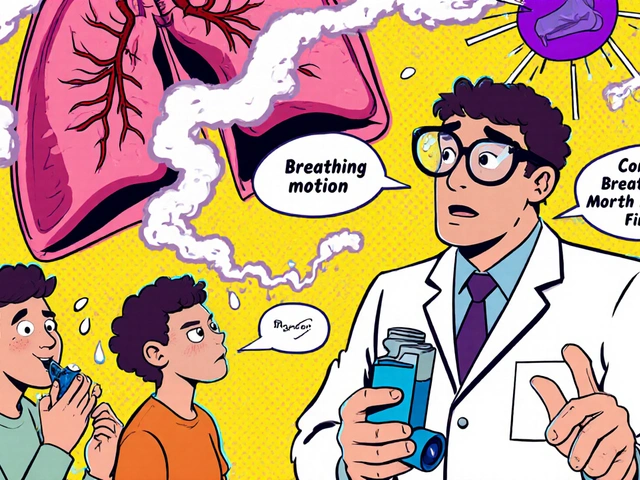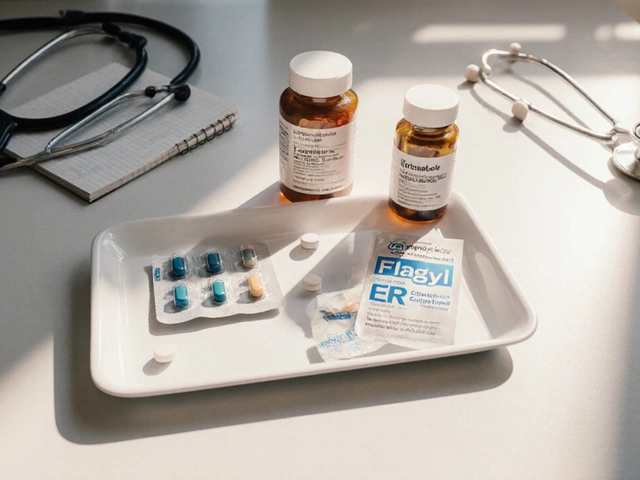Getting your medication right isn’t just about taking it - it’s about taking it correctly, consistently, and on time. For people using inhalers, skin patches, or injectables, missing doses or using devices improperly isn’t just a slip-up - it can lead to hospital visits, worsening symptoms, or even death. Studies show that between 30% and 70% of patients don’t take their medications as prescribed. The problem isn’t laziness. It’s complexity, confusion, and a lack of support. The good news? There are proven, practical ways to fix this - and they vary depending on whether you’re using an inhaler, a patch, or an injection.
Why Adherence Matters More Than You Think
When someone with asthma skips their inhaler, their airways swell. When a diabetic misses an insulin injection, their blood sugar spikes. When a patient with chronic pain skips a patch, pain returns, sleep breaks down, and mood suffers. These aren’t small issues. In the U.S. alone, poor medication adherence causes 125,000 deaths each year and adds $100-289 billion to healthcare costs. For people on long-term treatments, adherence isn’t optional - it’s the difference between managing a condition and being controlled by it.
But here’s the catch: most people aren’t failing because they don’t care. They’re failing because the system doesn’t work for them. Inhalers are hard to use correctly. Patches irritate the skin. Injectables feel intimidating. And no one reminds you - until you’re in the ER.
Fixing Inhaler Use: Technique + Technology
Inhalers are the most common cause of medication failure. A 2022 study found that up to 80% of asthma and COPD patients use their inhalers incorrectly. They don’t coordinate breathing with pressing the canister. They don’t hold their breath. They don’t rinse their mouth. And they don’t know they’re doing it wrong.
The fix starts with training. A pharmacist spending 20 minutes showing you how to use your inhaler - with a spacer, with the right technique - improves correct use by 40%. But training alone doesn’t stick. That’s where smart inhalers come in.
Devices like Propeller Health or Teva’s AirDuo RespiClick attach a tiny sensor to your inhaler. It records every puff, time, and location. That data syncs to your phone. You get reminders. You see your usage patterns. In one trial, patients using smart inhalers increased adherence from 55% to 82% in just three months.
But it’s not perfect. Some users say the constant alerts make them anxious. Others report apps crashing on older Android phones. And if your insurance doesn’t cover it - which only 37% of U.S. plans do - the device costs $100-300 a year.
Best practice? Combine hands-on training with a smart inhaler if you can afford it. If not, ask your pharmacist for a demo. Record yourself using it on your phone. Watch it back. Do it again. Until it’s automatic.
Improving Patch Adherence: Skin, Stick, and Simplicity
Patches are supposed to be easy. Stick it on, forget about it. But skin irritation, poor adhesion, and forgetfulness wreck adherence. A 2022 survey found that 31% of insulin patch users stopped using theirs because their skin got red, itchy, or sore.
The solution isn’t just switching brands. It’s rotation. Always apply your patch to a new spot - upper arm, lower back, thigh. Don’t reuse the same area. Let your skin breathe for at least a week before reusing a spot.
Some patches now come with built-in sensors. Proteus Digital Health’s system includes an ingestible sensor that activates when the patch is absorbed. It sends a signal to your phone. But this tech is still rare, expensive, and not widely covered by insurance.
For most people, simple wins. Set a daily phone alarm. Use a medication calendar. Put your patch pack next to your toothbrush or coffee maker. If you forget, your body will remind you - with pain, fatigue, or high blood sugar. Make the reminder part of your routine, not an afterthought.
And if your skin reacts? Talk to your doctor. There are hypoallergenic patches, adhesive sprays, and even alternative delivery methods. Don’t suffer in silence - or worse, skip doses because the patch hurts.

Injectables: Overcoming Fear and Complexity
Injectables - insulin, biologics, hormone shots - scare people. The needle. The dose. The storage. The fear of doing it wrong. A Novo Nordisk study found that 22% of caregivers found connected insulin pens too complicated. That’s not the patient’s fault. It’s bad design.
Smart pens like Novo Nordisk’s NordiFlex or Sanofi’s Solostar track every injection: time, dose, location. They sync to an app. They remind you. They even flag if you’re injecting too close to the last site. One study showed a 27% improvement in dose accuracy.
But tech alone doesn’t solve fear. The real fix is education and support. Start with a nurse or pharmacist walking you through the process. Practice on an orange. Learn how to rotate injection sites. Understand why timing matters - insulin before meals, biologics on the same day each week.
For elderly patients or those with arthritis, look for pens with larger buttons, easier grips, or auto-injectors. Some now have voice prompts. Others vibrate when the dose is complete. These aren’t luxuries - they’re necessities for long-term use.
And if you’re scared? You’re not alone. Ask your doctor about needle-free options. Some insulin formulations now come in oral pills or inhaled forms. New delivery systems are coming fast - and they’re designed to make adherence easier, not harder.
The 5 Dimensions of Adherence
Dr. Richard B. Martinello from Yale New Haven Health says successful adherence programs must fix five things: affordability, accessibility, acceptability, awareness, and activation.
- Affordability: Can you pay for the medication? If not, ask about patient assistance programs. Many drugmakers offer free or low-cost versions.
- Accessibility: Can you get it? Is your pharmacy nearby? Do you need help transporting it? Home delivery services exist for patches and injectables.
- Acceptability: Do you hate the side effects? The smell? The stigma? Talk to your doctor. There might be alternatives.
- Awareness: Do you know why you’re taking it? Many patients don’t understand how their inhaler prevents a flare-up. Education changes behavior.
- Activation: Are you in charge? Or are you waiting for someone else to remind you? The best systems put you in control - with tools, not guilt.
Fix one dimension, and adherence improves. Fix three, and you change your health trajectory.

What Actually Works - And What Doesn’t
Not all advice is equal. Here’s what the data says:
- Works: Pharmacist counseling (reduces hospitalizations by 28%), smart inhalers (35% higher adherence), daily reminders tied to routines (brushing teeth, eating breakfast), and extended-release formulations (like Depakote ER) that need fewer doses.
- Works sometimes: Pillboxes, paper calendars, basic phone alarms. These help - but only if you use them every day.
- Doesn’t work: Scolding patients. Blaming them for forgetting. One-size-fits-all apps that don’t adjust to your life. And electronic systems that overreport adherence by 15-20% because they track device use, not actual medicine delivery.
The most effective plan? Start with a simple tool: the Morisky 8-item scale. It’s a quick questionnaire your pharmacist can give you. It asks things like, “Do you ever skip doses when you feel better?” or “Do you forget to take your meds?” Your score tells you where you’re most likely to slip.
Then, pick two fixes that match your biggest barriers. If you forget? Use a smart device. If you’re scared? Get a demo. If it’s too expensive? Ask for help.
What’s Coming Next
By 2027, Deloitte predicts 75% of inhalers will have built-in tracking. Patches will monitor skin absorption. Injectables will auto-adjust doses based on your glucose levels. AI will predict when you’re about to miss a dose - and send a text before you forget.
But tech won’t fix everything. The real breakthrough is human-centered design. Devices that fit your life, not the other way around. Apps that don’t nag. Systems that empower, not monitor.
And the biggest change? Insurance. Right now, only 29% of Medicare Advantage plans cover smart inhalers. But that’s rising. As costs drop and outcomes improve, coverage will follow. The goal isn’t just to track adherence - it’s to make it effortless.
Start Today - One Small Step
You don’t need a smart inhaler or a connected pen to improve adherence. You just need to start.
Today, ask your pharmacist: “Can you show me how to use this correctly?”
Tomorrow, set a phone alarm for your next dose - tied to a habit you already do.
This week, write down one reason you’ve missed a dose. Then find one way to fix it.
Adherence isn’t about perfection. It’s about progress. One correct puff. One patch stuck on. One injection done on time. That’s how you take back control.







David Cunningham
November 24, 2025 AT 09:07Been using an inhaler for 12 years. The dumbest thing I did was never ask how to use it right. Just assumed I knew. Turned out I was puffing like a dragon and not holding my breath. Took a pharmacist 5 minutes to fix it. Life changed.
Jessica Correa
November 25, 2025 AT 03:09i just started using a patch for my thyroid and my skin is on fire honestly like why does it have to burn so much i just want to feel normal not get a rash every week
james lucas
November 25, 2025 AT 16:58the smart inhalers sound cool but like my phone dies by 3pm and i dont wanna be chasing notifications all day just to remember to breathe also why is everything $300 these days
New Yorkers
November 27, 2025 AT 06:27you know what’s really tragic? that people are dying because they can’t afford a $100 sensor when Big Pharma is making billions off their desperation. This isn’t a medical failure-it’s a moral one. We treat adherence like a personal flaw instead of a systemic crime.
Latonya Elarms-Radford
November 28, 2025 AT 13:20Let’s be honest: adherence isn’t about discipline, it’s about ontology. We are not merely biological machines that malfunction when we forget to press a button-we are beings entangled in systems of alienation, commodified health, and neoliberal self-surveillance. The smart inhaler doesn’t cure non-adherence; it merely quantifies our existential failure in real-time, turning breath into data points for corporate dashboards. The real question isn’t how to improve compliance-it’s how to dismantle the architecture that makes compliance a moral burden rather than a shared social responsibility.
Mark Williams
November 29, 2025 AT 14:34Interesting data on the 80% incorrect inhaler use-but have we controlled for cognitive load? Patients managing diabetes, hypertension, depression, and now a smart device? The cognitive overhead may be the real bottleneck. We need UX-first design, not just telemetry. Also, what’s the false positive rate on device-reported adherence? Are we measuring actuation or actual pulmonary deposition?
Ravi Kumar Gupta
December 1, 2025 AT 08:16In India, we don’t have smart inhalers. We have grandmas who remember to give insulin shots because they tie it to tea time. We have families who hold hands and say prayers before injections. Technology doesn’t fix loneliness. Community does. Why are we designing for Silicon Valley and ignoring the village?
Rahul Kanakarajan
December 1, 2025 AT 10:27Everyone’s talking about tech but nobody’s talking about the fact that most people don’t even know what their meds are for. My cousin takes his patch because his doctor said so. He doesn’t know it’s for pain, not blood pressure. How can you follow something you don’t understand? Stop blaming patients. Start explaining better.
manish chaturvedi
December 2, 2025 AT 20:55As someone who has seen both rural clinics in Uttar Pradesh and urban hospitals in New York, I can say this: the solution is not more gadgets, but more trained community health workers. One person who can show, demonstrate, and return to check in-this is what saves lives. Not apps. Not sensors. People.
Nikhil Chaurasia
December 3, 2025 AT 01:26I understand the need for innovation, but I worry about the emotional toll. Every ping, every alert, every reminder-it feels like the body is being watched. For those of us who already feel like our illness defines us, is this empowerment… or surveillance? I don’t need another thing to feel guilty about.
Holly Schumacher
December 4, 2025 AT 21:14Did you know that 78% of patients who use smart inhalers still lie to their doctors about adherence? The data is wrong. The tech is a placebo. And the real problem is that we’ve outsourced accountability to algorithms instead of building trust. Also, your grammar is atrocious. It’s ‘it’s’ not ‘its.’ Fix it.
Michael Fitzpatrick
December 5, 2025 AT 14:39just wanted to say i’ve been on insulin for 15 years and the biggest thing that helped me was having my sister text me every morning at 7am with a coffee emoji. no app. no sensor. just someone who cared enough to check in. sometimes the simplest thing is the most powerful. you’re not alone out there.
Shawn Daughhetee
December 6, 2025 AT 11:19my dad uses a smart pen and it works great but he hates the app because it beeps too loud and he thinks its spying on him so now he just uses the pen without the phone and still takes his shots on time. tech is a tool not a boss
steve o'connor
December 8, 2025 AT 11:15My mum used to forget her patches until we started putting them next to her glasses. Now she puts them on right after she puts on her reading specs. Simple. Habit-based. No tech needed. Sometimes the best solution is just tying it to something you already do every day.
luke young
December 8, 2025 AT 11:25Reading all this made me realize I’ve been judging people who miss doses without realizing how hard it is. I used to think it was laziness. Now I see it’s a system failure. Thanks for the perspective. I’m gonna ask my pharmacist for a demo tomorrow.